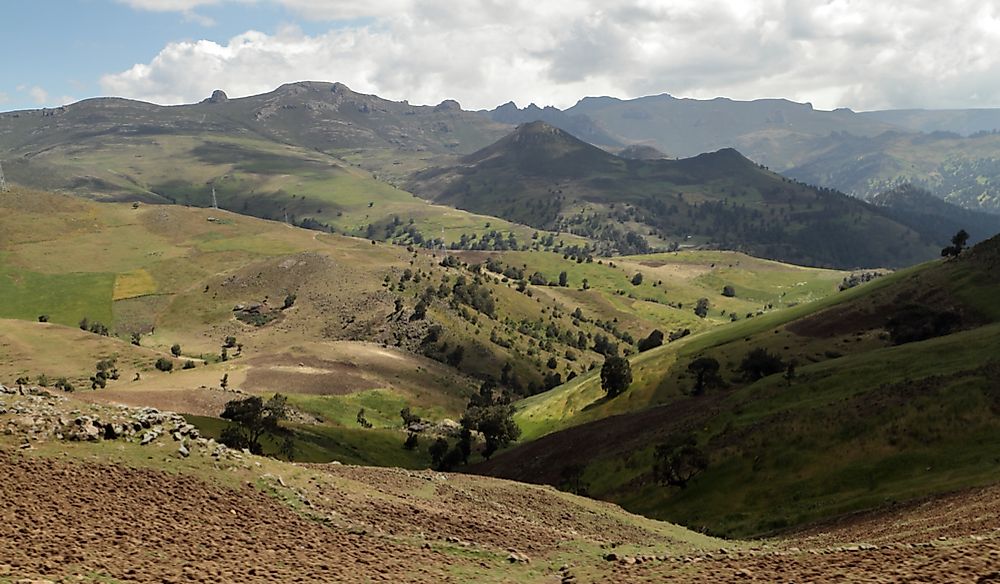Where Are The Bale Mountains?

The Bale Mountains are a mountain range in southeastern Ethiopia. Located in the country's Oromia Region, the Bale Mountains form part of the Ethiopian Highlands. The Bale Mountains include Mount Batu and Tullu Dimtu, which is the second highest peak in Ethiopia. Bale Mountains National Park, which is situated about 93 miles east of Shashamene and 248 miles from Addis Ababa, and occupies an area of about 860 square miles, is also located within the Bale Mountains.
Geology of the Bale Mountains
The Bale Mountains were created before the formation of the Great Rift Valley, from outpourings of lava that covered all underlying rock formations. More specifically, estimates suggest that the mountains were created between thirty-eight and seven million years ago. Some of the rocks from the volcanic outpours include basalts, tuffs, trachytes, and rhyolite. The central part of the highland has six volcanic cones that have an elevation of at least 13,780 ft. The striations on the shallow mountainside on Sanetti Plateau are a unique geological feature of the Bale Mountains that has puzzled geologists for years.
Glaciations
The Bale Mountains have experienced two glacial periods, the most recent of which occurred approximately 2,000 years ago. The range was the most glaciated area in the region during the last ice age, with ice that occupied an area of approximately 69 square miles. Tullu Dimtu, one of the highest peaks in the range, has an ice cap about 12 square miles in area. The current terrain is the outcome of lava outpourings, which have been modified by nearly 20 million years of erosion by ice, wind, and water. Before the beginning of deglaciation, which occurred about 14,000 years ago, the snowline on the mountains was at a height of 12,139 ft, and the upper tree-limit was below 9,843 ft. The change in climate over the last few centuries has impacted the biodiversity and vegetation in the highland.
Tallest Peaks in the Bale Mountains
Tullu Dimtu
With an elevation of 4,377 m, Tullu Dimtu is the fourth highest peak in Ethiopia, after Kidus Yared, Ancua, and Ras Sashen. Tullu Dimtu’s topographical prominence is relatively low since it is situated in the Sanetti Plateau. However, Tullu Dimtu is one of the tallest mountains in the Bale mountain range, and there is a long gravel road leading to the peak.
Mount Batu
Mount Batu is the highest mountain in the Oromia Region, reaching an elevation of about 4,307 m. Mount Batu has two peaks: Big Batu (Tilliq Batu) and Little Batu (Tinnish Batu). Despite the names, Tinnish Batu is actually higher than Tilliq Batu. Finnish professor Helmer Smeds was the first European to climb mount Batu in 1958.
Hydrology
The Bale Mountains have an important function in controlling the climate of the area by attracting a considerable amount of orographic precipitation. Areas of lower altitude receive between 23.6 inches and 39.4 inches of rainfall annually, while areas of higher altitude receive about 55 inches of rain. Nearly 12 million people from Ethiopia, Somalia, and Kenya benefit from the water that comes from Bale massif. More than 40 rivers rise from the Bale Mountains National Park, and these rivers contribute to five main rivers: the Ganale, Dumal, Welmel, Wabe Shebele, and Web. Bale massif is also the source of various lowland springs that are important to the local area since they are the only year-round source of water. Two of the main rivers originating from the Bale Mountains, the Yadot and Wabe Shebele, generate hydroelectric power.











